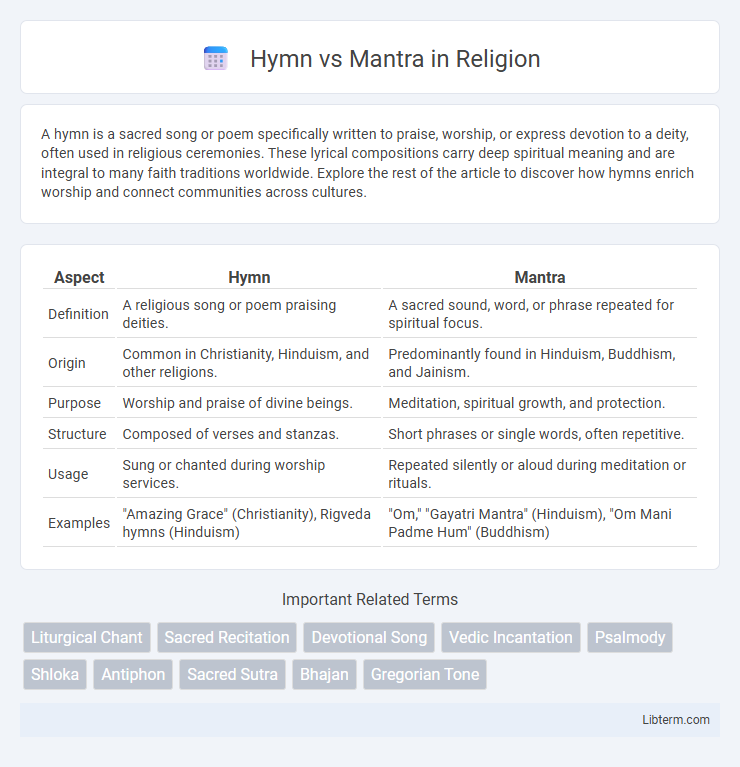A hymn is a sacred song or poem specifically written to praise, worship, or express devotion to a deity, often used in religious ceremonies. These lyrical compositions carry deep spiritual meaning and are integral to many faith traditions worldwide. Explore the rest of the article to discover how hymns enrich worship and connect communities across cultures.
Table of Comparison
| Aspect | Hymn | Mantra |
|---|---|---|
| Definition | A religious song or poem praising deities. | A sacred sound, word, or phrase repeated for spiritual focus. |
| Origin | Common in Christianity, Hinduism, and other religions. | Predominantly found in Hinduism, Buddhism, and Jainism. |
| Purpose | Worship and praise of divine beings. | Meditation, spiritual growth, and protection. |
| Structure | Composed of verses and stanzas. | Short phrases or single words, often repetitive. |
| Usage | Sung or chanted during worship services. | Repeated silently or aloud during meditation or rituals. |
| Examples | "Amazing Grace" (Christianity), Rigveda hymns (Hinduism) | "Om," "Gayatri Mantra" (Hinduism), "Om Mani Padme Hum" (Buddhism) |
Introduction to Hymns and Mantras
Hymns are structured verses often composed in praise of deities or to express religious devotion, traditionally found in various cultures and religions such as Hinduism and Christianity. Mantras are specific sound formulas or phrases repeated during meditation or ritualistic practices to invoke spiritual energy and focus the mind, deeply rooted in Vedic and Buddhist traditions. Both serve as powerful tools for spiritual connection, with hymns emphasizing lyrical praise and mantras focusing on vibrational sound repetition.
Origins and Historical Background
Hymns originated in ancient religious traditions, often composed as structured poetic songs praising deities and used in communal worship across cultures like ancient Greece and India. Mantras trace back to early Vedic traditions in India, where they were sacred sound formulas or phrases believed to hold spiritual power and used primarily in meditation and ritual chanting. Both hymns and mantras have deep historical roots, yet hymns emphasize lyrical praise while mantras focus on repetitive sound vibrations for spiritual effects.
Definitions: What is a Hymn? What is a Mantra?
A hymn is a structured song or poem composed to praise, worship, or express devotion to a deity or spiritual concept, often used in religious ceremonies and communal gatherings. A mantra is a sacred utterance, sound, syllable, word, or group of words believed to have spiritual power, frequently repeated in meditation or prayer to focus the mind and invoke divine energy. Both hymns and mantras play significant roles in spiritual practices but differ in form, purpose, and usage within various religious traditions.
Cultural and Religious Contexts
Hymns are structured songs of praise typically found in Christian, Hindu, and Islamic traditions, serving communal worship and ritual purposes, while mantras are repetitive sacred sounds or phrases in Hinduism, Buddhism, and Jainism used for meditation and spiritual focus. Hymns often have lyrical content praising deities or recounting religious stories, whereas mantras emphasize phonetic vibration believed to invoke spiritual power. Both play central roles in religious practices, yet hymns are generally sung aloud in group settings, and mantras are recited silently or aloud for personal or ritualistic meditation.
Linguistic Structure and Composition
Hymns typically feature structured poetic forms with metrical patterns and rhyme schemes, designed for communal singing or chanting within religious rituals, often composed in classical languages such as Latin or Sanskrit. Mantras are concise, repetitive phrases or sounds with precise phonetic arrangements aimed at focusing the mind and invoking spiritual power, frequently utilizing specific vowel and consonant combinations to enhance vibrational qualities. The linguistic composition of hymns emphasizes narrative and praise, while mantras prioritize phonological precision and rhythmic repetition for meditative effects.
Purposes and Uses in Spiritual Practice
Hymns serve as structured songs of praise and devotion, used in spiritual practice to express collective worship and invoke divine presence, often performed in rituals and ceremonies. Mantras function as repetitive sounds or phrases aimed at focusing the mind, facilitating meditation, and harnessing spiritual energy for personal transformation and inner peace. Both play crucial roles in enhancing spiritual connectivity, with hymns fostering communal unity and mantras supporting individual concentration.
Methods of Recitation and Performance
Hymns are traditionally recited in a melodic and structured chant, often performed collectively during rituals and ceremonies to evoke communal participation and spiritual ambiance. Mantras are typically repeated in a precise, rhythmic manner, focused on individual meditation or concentration to harness their vibrational power and mental clarity. The performance of hymns emphasizes vocal harmony and lyrical expression, while mantras prioritize repetition, intonation, and mental focus for transformative effects.
Psychological and Spiritual Effects
Hymns typically evoke communal connection and emotional uplift through melodic repetition, enhancing group cohesion and spiritual transcendence. Mantras focus on individual mental discipline and mindfulness, promoting deep concentration and inner calm by rhythmic chanting or silent repetition. Both practices influence brainwave activity, reducing stress and fostering altered states of consciousness conducive to spiritual growth.
Modern Adaptations and Influences
Modern adaptations of hymns often integrate contemporary musical styles and digital media to reach broader audiences, blending traditional spiritual themes with pop, rock, and electronic elements. Mantras have influenced mindfulness and wellness practices worldwide, with repetitive chanting integrated into yoga, meditation apps, and therapy sessions to enhance mental clarity and stress reduction. Both hymns and mantras continue to evolve by merging ancient traditions with modern cultural expressions, fostering global spiritual engagement.
Comparative Analysis: Key Differences and Similarities
Hymns typically consist of structured poetic verses praising deities or expressing devotional themes, often used in communal worship settings, whereas mantras are repetitive sound syllables or phrases believed to hold spiritual power and used primarily in meditation or rituals. Both hymns and mantras serve as tools for spiritual focus and invocation, with hymns emphasizing lyrical expression and mantras focusing on phonetic vibrations. The key difference lies in their function and form: hymns convey narrative or doctrinal content, while mantras function as sonic vehicles for mental concentration and energetic transformation.
Hymn Infographic

 libterm.com
libterm.com